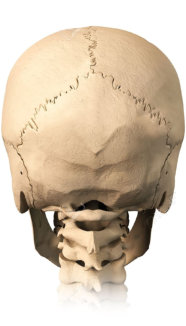
Cranial Adjusting is a gentle hands-on technique that uses a light touch to examine membranes and movement of the fluids in and around the central nervous system. Relieving tension in the central nervous system promotes a feeling of well-being by eliminating pain and boosting health and immunity.
The focus of CST is a gentle placement of hands to assist release of the body’s connective tissue, or “fascia.” Fascia (Latin word for “band”) is a covering found throughout the body including organs, glands, nerves, muscles, blood vessels, brain and spinal cord. This covering forms a body-wide connective network. CST is based on the idea that the body is interrelated at all levels.
CST is thought to improve efficiency of biological processes through boosting inherent self-regulation, self-correction and self-healing. The therapy can be used successfully with children and adults.
Though most people assume chiropractors mainly deal with the neck and spine, chiropractors can treat a wide variety of conditions, including head injuries or cranial damage. Damage can happen during pregnancy or childbirth, injury or trauma during childhood, or due to a concussion later in life.
Sometimes head injuries can even disrupt or misalign the bones of the skull and result in various health problems. If not corrected, these issues can become chronic and cause a lifetime of pain, cognitive disorders, learning disabilities, and other health problems.

What are cranial adjustments? Isn’t the skull just one bone?
Cranial adjustments are a form of chiropractic treatment used to treat misalignments within the skull or face as these misalignments can lead to a wealth of health problems when not treated.
The skull is composed of thirteen separate bones that fit together like a puzzle, but they are not fixed or fused. Instead, these bones are held together with connective soft tissue and blood vessels. Though the amount of movement between the bones is small, they can become misaligned through trauma or injury. These misalignments can interfere with the central nervous system or blood supply to the brain resulting in an onset of health problems.
Chiropractors use light force either with their hands or an adjusting instrument to unlock or release the misalignments, removing the pressure on the brain and neurological system as a whole.
What happens during cranial misalignment?
These misalignments can interfere with the cerebral spinal fluid that naturally flows throughout the brain helping to control the body. The symptoms or effects of cranial misalignments vary depending on the parts of the brain that are misaligned. For example, the mandible or maxilla being misaligned can result in jaw pain, sinus problems, tender gums and teeth, oral health complications, and even problems with balance. Misalignments that occur during childbirth or early childhood may result in cognitive disorders, speech impairment, and learning difficulties. Other common symptoms include chronic headaches or migraines, vision problems, auditory problems, nausea, emotional problems, and behavior problems.
Is it painful?
No. Many patients report that they are very relaxed during cranial adjustments and feel no pain, but some say they experience a feeling of light-headedness or fatigue afterward. However, it is very safe. This is even true for children and can be very important for them if they do suffer from misalignments as cranial bones need to expand and contract while the brain grows during childhood. If the cranial bones do not return to their normal alignment, this can lead to health and developmental issues.
Who can benefit from cranial adjustments?
Anyone who has suffered trauma to the head should be examined for misalignments. Cranial adjustments are not just for the young or elderly.
We would like to stress that our treatment for cranial adjustments is to correct the misalignments, not to absolve the specific conditions that may result in or be symptoms of cranial misalignments.

